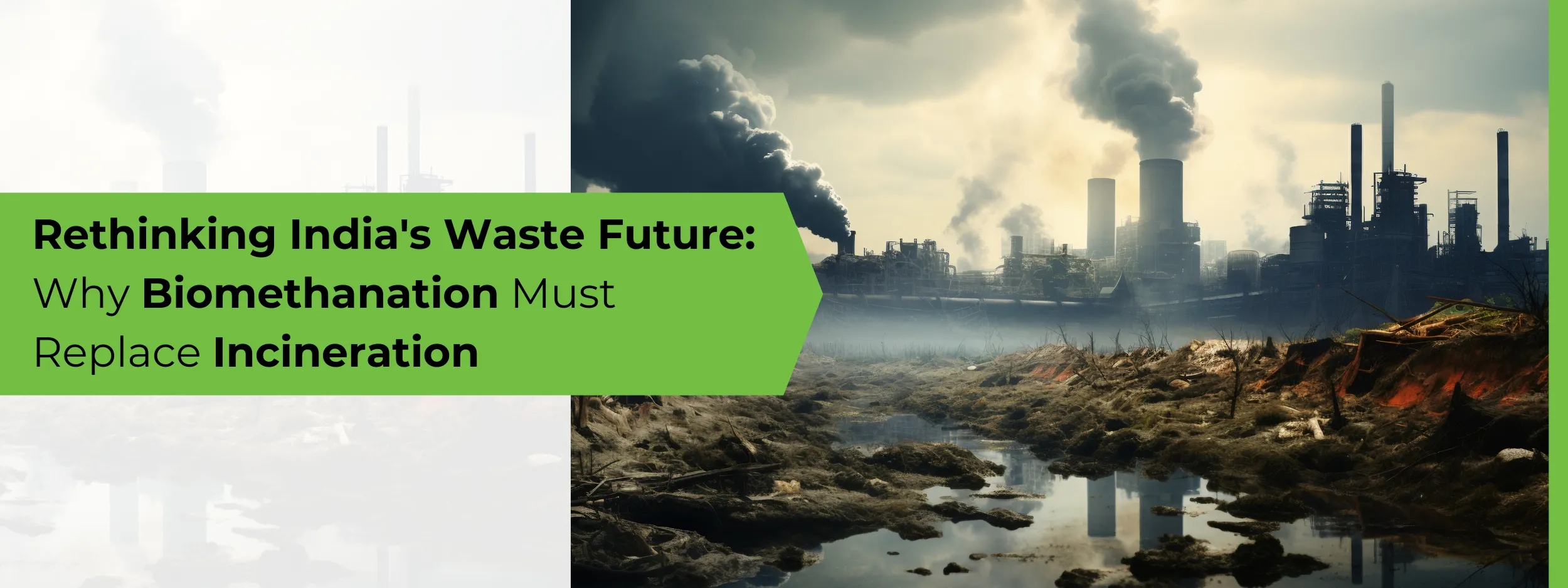
Rethinking India’s Waste Future: Why Biomethanation Must Replace Incineration
India’s waste crisis demands a systemic, future-ready response. With urban centres generating over 1.5 lakh tonnes of municipal solid waste (MSW) daily, much of it organic, choosing the right waste-to-energy (W2E) strategy is critical. Yet, the prevailing push for incineration-based W2E plants often ignores a core fact: India’s waste is predominantly wet.
In contrast, biomethanation (anaerobic digestion) is a cleaner, decentralised, and financially viable solution, better suited to India’s waste characteristics and development priorities. A side-by-side evaluation based on core operational and economic factors reveals why biomethanation must become the centrepiece of India’s urban sustainability roadmap.
Feedstock Suitability
Biomethanation is designed for wet organic waste, such as food scraps, vegetable market waste, and kitchen discards, which comprise over 50% of India’s MSW stream. It utilises microbes under anaerobic conditions to break down this organic matter and produce biogas
Incineration, in contrast, requires dry, high-calorific waste to function effectively. Given the high moisture and organic content of Indian waste, incinerators often underperform or require significant pre-processing, adding cost, complexity, and inefficiency.
Waste Segregation Compatibility
Biomethanation requires source-segregated organic waste for optimal performance. As more municipalities implement segregation-at-source policies, this becomes increasingly feasible and advantageous.
Incineration can handle mixed waste, which makes it attractive for urban local bodies (ULBs) where segregation systems remain weak. However, this often leads to incomplete combustion and operational failures due to unsuitable feedstock.
Energy Output
Biomethanation produces compressed biomethane (CBG), a clean and renewable substitute for CNG, LPG, or diesel.
Incinerators convert waste to electricity using steam turbines, but their energy efficiency drops significantly when dealing with high-moisture waste. This reduces their reliability as consistent power generators.
Byproducts and Residue Management
Biomethanation results in digestate, a nutrient-rich byproduct that can be processed into organic fertiliser. When handled to meet FCO standards, this offers a valuable input for India’s growing organic agriculture sector.
Incineration produces toxic residues fly ash, bottom ash, and dioxins, requiring specialised and costly treatment. These residues have no role in the circular economy and present environmental risks.
GHG Emissions and Environmental Impact
Biomethanation is a low-emission process that captures methane that would otherwise escape from landfills, a major contributor to climate change.
Incineration releases greenhouse gases, particulate matter, and harmful chemicals, demanding advanced pollution control systems. In densely populated areas, this often becomes a point of public opposition and regulatory scrutiny.
Revenue Streams
Biomethanation supports a diverse revenue model through the sale of CBG, carbon credits, organic fertiliser (once standardised), and tipping fees from ULBs. These multiple income sources enhance both financial viability and long-term project sustainability.
Incinerators rely largely on the sale of electricity to DISCOMs, which often involves payment delays, reduced tariffs, and weak offtake guarantees, making the financial model volatile and risk-prone.
CAPEX & OPEX Considerations
Biomethanation projects typically have moderate capital costs and lower operating expenses, particularly when feedstock is subsidised or supplied free by municipalities.
Incineration facilities involve high capital investment due to pollution control equipment and elevated operating costs from fuel drying, combustion control, and ash handling.
Scalability and Decentralisation
Biomethanation is inherently modular and scalable. Plants ranging from 5 to 100 TPD can be integrated into city wards, campuses, or agricultural clusters, enabling decentralised waste processing at source.
Incineration, by design, favours large, centralised plants (often over 300 TPD) to achieve cost efficiency—this increases waste transportation requirements and reduces local participation.
Job Creation and Local Ecosystem Integration
Biomethanation supports local employment in waste collection, plant operations, logistics, and fertiliser distribution. It also fosters integration with the informal sector and community-run models.
Incinerators require fewer local jobs and minimal interaction with decentralised systems, limiting community involvement and potential socioeconomic benefits.
Community Acceptance
Biomethanation is gaining traction as a clean, localised, and circular economy-aligned solution. Its ability to run quietly, with minimal emissions and direct community benefits, strengthens social license and builds public trust.
Incineration, however, often faces public opposition due to concerns over air pollution, health impacts, and past failures of similar projects in Indian cities.
Financial Viability
Biomethanation projects can be financially sustainable when supported by tipping fees, gas sales, and fertiliser revenue. They are increasingly eligible for green finance, ESG-aligned investments, and climate-linked funds.
Many incineration-based W2E projects in India are currently loss-making, driven by poor feedstock quality, high operating costs, and inconsistent energy performance.
Conclusion: Time for a Strategic Shift
India’s waste profile, energy priorities, and climate commitments demand a practical, decentralised, and regenerative W2E model. Biomethanation meets all three. Its ability to turn wet organic waste into clean energy and organic fertiliser while creating jobs, cutting emissions, and boosting local economies positions it as a cornerstone of sustainable urban planning.
What’s needed now is regulatory alignment, especially around digestate recognition under FCO, organic fertiliser incentives, and contracting models that reward decentralisation. With the right support, biomethanation can power not only cleaner cities but also a more resilient and greener agricultural future.
